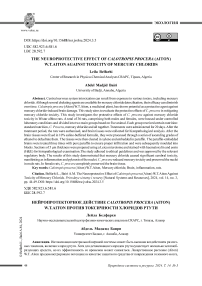The neuroprotective effect of Calotropis procera (Aiton) W.T.Aiton against toxicity of mercury chlorids
Автор: Belfarhi L., Bairi A.M.
Журнал: Природные системы и ресурсы @ns-jvolsu
Рубрика: Экология
Статья в выпуске: 3 т.14, 2024 года.
Бесплатный доступ
Central nervous system intoxication can result from exposure to various toxins, including mercury chloride. Although several chelating agents are available for mercury chloride detoxification, their efficacy can diminish over time. Calotropis procera (Aiton) W.T.Aiton, a medicinal plant, has shown potential as a protective agent against mercury chloride-induced brain damage. This study aims to evaluate the protective effects of C. procera in mitigating mercury chloride toxicity. This study investigates the protective effects of C. procera against mercury chloride toxicity in Wistar albino rats. A total of 36 rats, comprising both males and females, were housed under controlled laboratory conditions and divided into two main groups based on five animal. Each group received certain nutrition: standard nutrition, C. Procera , mercury chloride and all together. Treatments were administered for 20 days. After the treatment period, the rats were euthanised, and brain tissues were collected for histopathological analysis. After the brain tissues were fixed in 10% saline-buffered formalin, they were processed through a series of ascending grades of ethanol to dehydrate them. The tissues were then cleared in xylene and embedded in paraffin. The paraffin-embedded brains were treated three times with pure paraffin to ensure proper infiltration and were subsequently moulded into blocks. Sections of 5 µm thickness were prepared using a Leica microtome and stained with haematoxylin and eosin (H&E) for histopathological examination.The study adhered to ethical guidelines and was approved by the relevant regulatory body. The results of this study demonstrated that mercury chloride caused significant cerebral toxicity, manifesting as inflammation and pyknosis of the nuclei. C. procera reduced mercury toxicity and preserved the nuclei in male rats. In female rats, C. procera completely preserved the brain tissue.
Calotropis procera (aiton) w.t.aiton, mercury chloride, brain, inflammation, rats
Короткий адрес: https://sciup.org/149147340
IDR: 149147340 | УДК: 582.923.6:581.6 | DOI: 10.15688/nsr.jvolsu.2024.3.5
Список литературы The neuroprotective effect of Calotropis procera (Aiton) W.T.Aiton against toxicity of mercury chlorids
- Bodakhe N., Kumar A. Neuroprotective Potential of Calotropis Gigantea: A Review. Journal of Pharmacy and Pharmacology, 2016, no. 68 (10), pp. 1270-1280. DOI: 10.1111/jphp.12634
- Dardouri K., Haouem S., Gharbi I., et al.Combined Effects of Cd and Hg on Liver and Kidney Histology and Function in Wistar Rats. Journal of Agricultural Chemistry and Environment, 2016, vol. 5, no. 5, pp. 159-169. DOI: 10.4236/jacen.2016.54017
- James A.K., Nehzati S., Dolgova N.V., et al. Rethinking the Minamata Tragedy: What Mercury Species Was Really Responsible? Environ. Sci. Technol., 2020, no. 54 (5), pp. 2726-2733. DOI: 10.1021/acs.est.9b06253
- Johnson L.W., Wolbarsht M.L. Mercury Poisoning: A Robable Cause of Isaac Newton's Physical and Mental Ills. Notes and Records of the Royal Society of London, 1979, no. 34 (1), pp. 1-9. DOI: 10.1098/rsnr.1979.0001
- Müller-Madsen B. Localization of Mercury in CNS of the Rat. V. Inhalation Exposure to Metallic Mercury. Archives of Toxicology, 1992, vol. 66.2, pp. 79-89. DOI: 10.1007/BF02342499 EDN: JUGBLX
- Oraibi A.I., Hamad M.N. Phytochemical Investigation of Flavanoid of Calotropis Procera in Iraq, Isolation and Identification of Rutin, Quercitin and Kampferol. J. Pharm. Sci. & Res., 2018, vol. 10, no. 9, pp. 2407-2411.
- Pathak S., Multani A.S., Banerji P., Banerji P.Ruta 6 Selectively Induces Cell Death in Brain Cancer Cells but Proliferation in Normal Peripheral Blood Lymphocytes: A Novel Treatment for Human Brain Cancer.International Journal of Oncology, 2003, vol. 23, no. 4, pp. 975-982.
- Suzuki T., Imura N., Clarkson T.W. Advances in Mercury Toxicology. Springer Science & Business Media, 1991. 490 p. DOI: 10.1007/978-1-4757-9071-9
- Teixeira F.B., de Oliveira A.C.A., Leгo L.K.R., et al. Exposure to Inorganic Mercury Causes Oxidative Stress, Cell Death, and Functional Deficits in the Motor Cortex. Frontiers in Molecular Neuroscience, 2018, vol. 11, pp. 125. DOI: 10.3389/fnmol.2018.00125
- Zaher A.M., Taha M.M.M., Ahmed H.G. Neurodegenerative Disorders Associated with Mercuric Chloride Toxicity in Mice and the Role of Some Antioxidant.International Journal of Science and Research, 2017, vol. 6, no. 4. pp. 1253-1260. DOI: 10.21275/ART20172479


